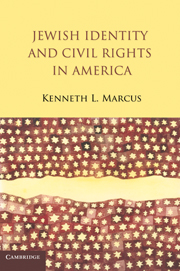Book contents
- Frontmatter
- Contents
- Acknowledgments
- Introduction
- 1 The Dilemma of Jewish Difference
- 2 The Jewish Question in Civil Rights Enforcement
- 3 The New Campus Anti-Semitism
- 4 Criticism
- 5 First Amendment Issues
- 6 Misunderstanding Jews and Jew Hatred
- 7 Institutional Resistance
- 8 The Originalist Approach
- 9 Scientific Theories
- 10 Social Perception
- 11 The Subjective Approach
- 12 Anti-Semitism as Harm to Racial Identity
- Conclusion
- Index
- References
8 - The Originalist Approach
Published online by Cambridge University Press: 05 June 2012
- Frontmatter
- Contents
- Acknowledgments
- Introduction
- 1 The Dilemma of Jewish Difference
- 2 The Jewish Question in Civil Rights Enforcement
- 3 The New Campus Anti-Semitism
- 4 Criticism
- 5 First Amendment Issues
- 6 Misunderstanding Jews and Jew Hatred
- 7 Institutional Resistance
- 8 The Originalist Approach
- 9 Scientific Theories
- 10 Social Perception
- 11 The Subjective Approach
- 12 Anti-Semitism as Harm to Racial Identity
- Conclusion
- Index
- References
Summary
The U.S. Supreme Court adopted an “originalist” approach in deciding, in St. Francis College and Shaare Tefila, respectively, that Congress intended to treat Arabs and Jews as “races” within the meaning of an earlier civil rights statute, the Civil Rights Act of 1866. That is to say, the Court focused on the original intent of the framers of the Civil Rights Act of 1866, as well as the public meaning of the statute at the time that it was enacted, in order to determine how the statute’s provisions should be interpreted today. The Court reasoned that Congress and the public considered groups such as Arabs and Jews to be racially distinct at the time when the statute was passed, even though they are generally considered to be Caucasians today. Some jurists support this methodological approach, known as “originalism,” on the ground that it most faithfully applies the terms to which the democratically elected branches agreed when they passed the underlying statute.
Both cases instructed that Congress had “intended to protect from discrimination identifiable classes of persons who are subjected to intentional discrimination solely because of their ancestry or ethnic characteristics.” It was this holding that OCR extended in its 2004 policy, when it announced that it would pursue cases of ethnic or ancestral discrimination targeting groups such as Sikhs, Arabs, and Jews. The concept of “ethnic or ancestral discrimination” is somewhat vague, and it seems intuitively to vary somewhat from the idea of “race.” Judge Richard Posner explained the Court’s use of this concept with admirable lucidity:
The awkward phrase, which appears in no statute, “ancestral discrimination” is an effort to convey in an inoffensive manner the dual character of anti-Semitism. There is religious anti-Semitism, typified by the attitude of the medieval Roman Catholic Church, and racial anti-Semitism, typified by Hitler. The one objects to Jews because of their religion, the other objects to Jews because they are descended from Jews, even if they are converts to other faiths. Nowadays the use of the term “race” is pretty much limited to the three major racial divisions – Caucasoid, Negroid, and Mongoloid – but historically the term was used much more broadly, to denote groups having common ancestry or even a common culture (or, as often, both). And in this sense Jews are members of a distinct race. The civil rights statutes enacted in the period of Reconstruction, in guaranteeing all persons the rights of white citizens, have been held to protect all groups that are “races” in the traditional loose sense, such as Jews and Arabs.
- Type
- Chapter
- Information
- Jewish Identity and Civil Rights in America , pp. 104 - 114Publisher: Cambridge University PressPrint publication year: 2010



